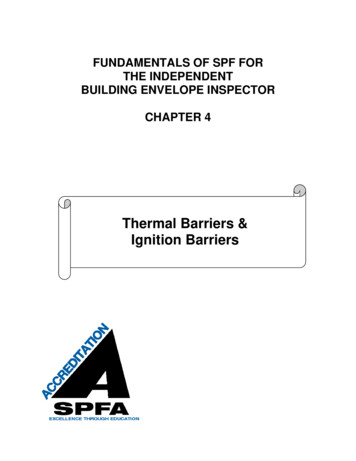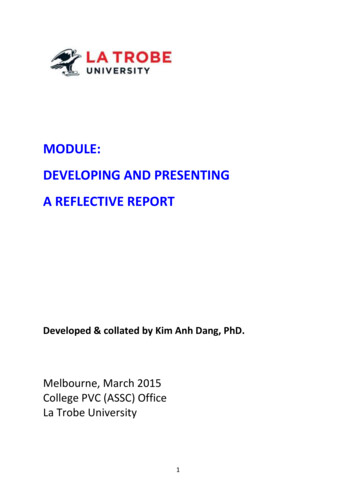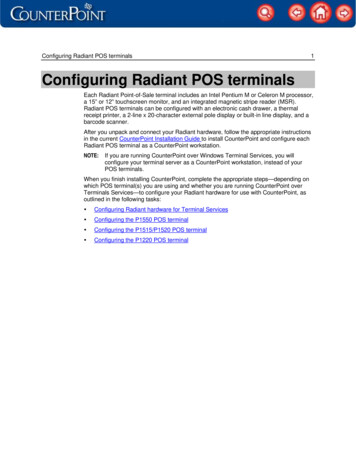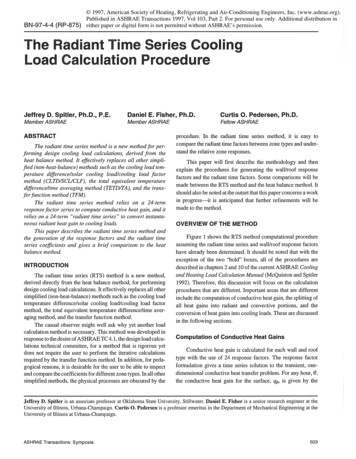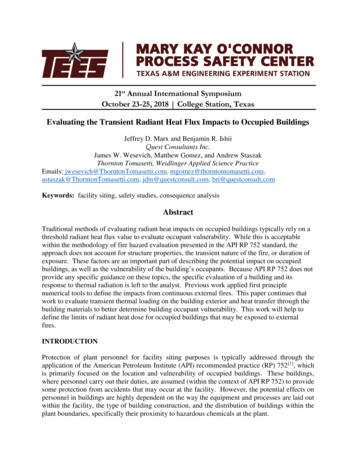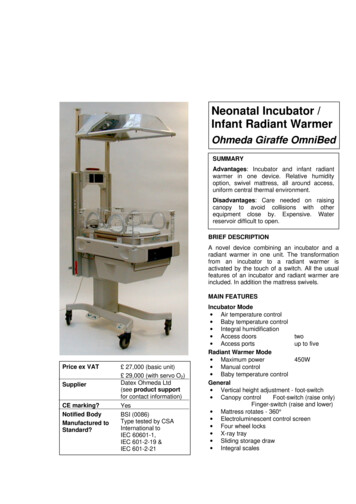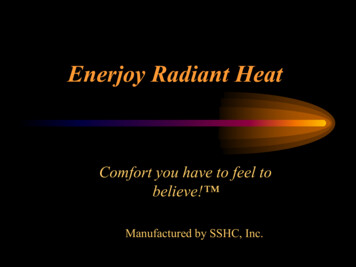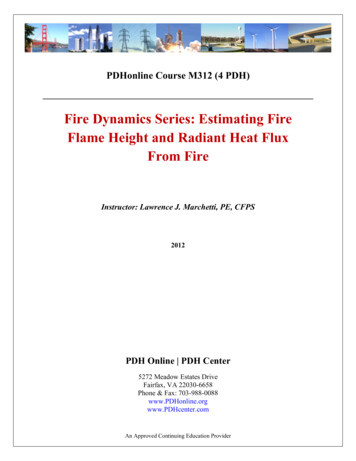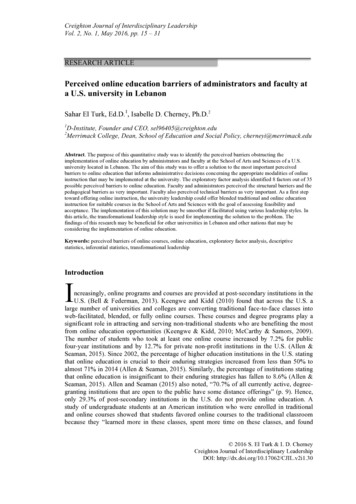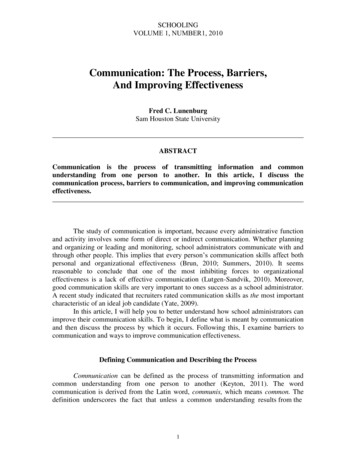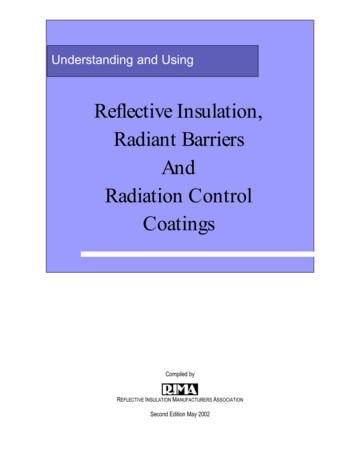
Transcription
Understanding and UsingReflective Insulation,Radiant BarriersAndRadiation ControlCoatingsCompiled byREFLECTIVE INSULATION MANUFACTURERS ASSOCIATIONSecond Edition May 2002
Second Edition Copyright May 2002Reflective Insulation Manufacturers Association (RIMA)4519 E. Lone Cactus Drive, Phoenix, AZ 85050Phone: 800-279-4123 z Fax 480-513-4749The Reflective Insulation Manufacturers Association (RIMA), its members, and/oragents, make no guarantee as to, and assume no responsibility for, the correctness,sufficiency or completeness of the information contained herein. The informationprovided herein is intended to be a guide to the concept and applications of reflectiveinsulation, radiant barriers and interior radiation control coatings.
TABLE OF CONTENTS1. ABOUT RIMA .12. INTRODUCTION .13. OBJECTIVES .14. FUNDAMENTALS OF HEAT TRANSFER.24.1 Conduction4.2 Convection4.3 Radiation5. THE NEED FOR INSULATION .56. REFLECTIVE INSULATION.66.1 Concept of Reflective Insulation .66.2 Understanding a Reflective Insulation System .76.3 Types of Reflective Insulation Materials .76.4 Applications for Reflective Insulation Materials .86.5 Installing Reflective Insulation Systems .97. RADIANT BARRIERS .107.1 Physics of Radiant Barriers .107.2 Radiant Barrier Systems (RBS).117.3 Types of Radiant Barrier Material.117.4 Installing Radiant Barriers .117.4.1 Attics .117.4.2 Walls .137.4.3 Floors.138. INTERIOR RADIATION CONTROL COATINGS (IRCC) .148.1 Definition of an IRCC.148.2 Physics on an IRCC .148.3 Definition on an Interior Radiation Control Coatings (IRCC).148.4 Advantages of an IRCC.148.5 Installation Methods for an IRCC.148.6 Typical Installations of Interior Radiation Control Coatings (IRCC) .158.6.1 Under Roof.158.6.2 Interior Side Walls.158.6.3 Exterior Side Walls.158.6.4 Other Possible Uses – Construction .158.7 Other Possible Uses of an IRCC.169. GLOSSARY OF TERMS .1610. REFERENCES .1710.1 Reviews .1710.2 Technical Papers.1710.3 Documents .1910.3.1 ASHRAE Handbook.1910.3.2 Federal Trade Commission.1910.3.3 International Conference of Building Officials (ICBO) .1910.3.4 U.S. Department of Energy .1910.4 ASTM Standards.2011. APPENDIX – INTRODUCTORY COMMENTS ON ESTIMATING THERMAL RESISTANCES FORREFLECTIVE INSULATION SYSTEMS.21
Reflective Insulation Manufacturers Association1.ABOUT RIMAThe Reflective Insulation Manufacturers Association (RIMA) is the only trade associationrepresenting the reflective insulation, radiant barrier and radiation control coatings industries.RIMA activities are guided by an active board of industry members that participate on nationaland local levels of building code organizations and governmental agencies.RIMA’s objective is to further the understanding and acceptance of reflective insulation,radiation control coatings, and radiant barriers. Toward this, RIMA members have contributedmany articles and information that have appeared in magazines and newsletters such as:Builder, Journal of Light Construction, Popular Mechanics, Popular Science, Architecture, RSI,Energy Design Update, Contractor’s Guide, Practical Homeowner, Rural Builder, MetalMagazine, Frame Builder NEWS, Metal Construction News, and Metal Architecture.RIMA has also contributed technical papers to various conferences and workshops sponsoredby the Department of Energy, ASHRAE, TVA, ASTM, and Oak Ridge National Laboratory.RIMA members meet twice a year in conjunction with the ASTM C-16 Committee meetings todiscuss current technical issues and establish standards that promote the best use of reflectiveinsulation, radiation control coatings, and radiant barrier products. RIMA’s members come froma variety of backgrounds including engineers, scientists, manufacturers, marketers, andacademicians.The RIMA Handbook aims to provide a simple yet comprehensive guide elaborating on thefundamentals of heat transfer and the concept of reflective insulation, radiant barriers andinterior radiation control coatings (IRCCs’).2.INTRODUCTIONThe key to maintaining a comfortable temperature in a building is to reduce the heat transfer outof the building in the winter and reduce heat transfer into the building in the summer.Heat is transmitted across confined air spaces by radiation, convection, and conduction. Thegoal is to reduce heating and cooling loads. Reflective insulation, radiant control coatings, andradiant barriers are products that perform this function by reducing radiant heat transfer therebyreducing the heating and cooling requirements.3.OBJECTIVES Discuss heat transfer, with an emphasis on radiant heat transfer. Explain the underlying principles of reflective insulation, radiant barriers and interiorradiation control coatings. Clarify the differences between these three reflective technologies and illustrate applicationsbest suited to each product. Provide a working knowledge of the effective use of reflective insulation, radiant barriers andinterior radiation control coatings.-1-
Reflective Insulation Manufacturers AssociationThe handbook does not intend to be a definitive source, but will cover some basic information.There are a large number of excellent authoritative publications about reflective technologiesand products. They are listed in section 10, References, and are recommended for additionalinformation and guidance. Our purpose in this section is to inform in an easily understandableway, the virtues of the reflective products represented by RIMA members.4.FUNDAMENTALS OF HEAT TRANSFERHeat flows from a hot or warm medium to a cold medium in three ways: 4.1By radiation from a warm surface to a cooler surface through an air spaceBy conduction through solid or fluid materialsBy convection, which involves the physical movement of airConductionConduction is the direct flow of heat through a material resulting from physical contact. Thetransfer of heat by conduction is caused by molecular motion in which molecules transfer theirenergy to adjoining molecules and increase their temperature.A typical example of conduction would be the heat transferred from hot coffee, through the cup,to the hand holding the cup. Another example, as shown above, the contents of the kettle boilsfrom heat transferred from the burner to the kettle. Also, a poker becomes hot from contact withhot coals.Heat transfer by conduction is governed by a fundamental equation known as Fourier’s Law.(Rate of Heat Flow) - k x (Area) x (Temperature Gradient)The factor k is called thermal conductivity or in the case of many insulation materials “apparentthermal conductivity”. This property is characteristic of the material and it varies withtemperature, density (degree of compaction), and composition. Some typical thermalconductivity and thermal resistivity data are given in the following table for the purpose ofcomparison.-2-
Reflective Insulation Manufacturers AssociationMaterialSawdustWood ShavingsStd. Fiberglass BattHigh PerformanceFiberglass BattLoose-Fill FiberglassLoose-Fill Rock WoolLoose-Fill CelluloseExpanded PolystyreneExtruded 0.2005.0GASESAir0.1815.5Carbon SEthylene ad2400.0042MISCELLANEOUS BUILDING MATERIALSAcoustical Tile0.402.5Asphalt5.20.19Concrete (140 lb/ft3)12.00.08Cotton (6 lb/ft3)0.303.3Window 5Yellow Pine1.040.96Plywood0.831.2(1)Values shown are at 75oF (approximately 300K)(2)Nominal values in Btu·in./ft2·hr·oF(3)Thermal resistivities in ft2·hr·oF/Btu·in.4.2ConvectionConvection in buildings is the transfer of heat caused by the movement of heated air. In abuilding space, warm air rises and cold air settles to create a convection loop and is termed freeconvection. Convection can also be caused mechanically, (termed forced convection), by a fanor by wind.-3-
Reflective Insulation Manufacturers AssociationTypical examples of heattransfer through convection:1. Warm air rising fromregister. (forced convection)2. Warm air rising from allsurfaces of radiator,(after air in contact withradiator has beenheated by conduction).3. Warm air rising fromchimney. (free convection)In the flow of heat through a solid body to air, it was observed that the passage of heat into theair was not accomplished solely through conduction. Instead, it occurred partly by radiation andpartly by free convection. A temperature difference existed between the hot solid and theaverage temperature of the air. In this case, the resistance to heat transfer cannot be computedusing the thermal conductivity of air alone. Instead, the resistance has to be determinedexperimentally by measuring the surface temperature of the solid, the temperature of air, andthe heat transferred from the solid to air. The resistance computed is the combined resistanceof conduction, free convection, and radiation. This resistance, denoted by the letter “R”, has theunits of (hr ft2 F/Btu) and is commonly used to indicate the thermal characteristics of insulationmaterials.4.3RadiationRadiation is the transfer of heat (infra-red radiant energy) from ahot surface to a cold surface through air or vacuum. Allsurfaces including a radiator, stove, a ceiling or roof andordinary insulation radiate to different degrees. The radiantheat is invisible and has no temperature, just energy. Whenthis energy strikes another surface, it is absorbed and increasesthe temperature of that surface. This concept can beunderstood with the following example: On a bright sunny day,radiant heat from the sun travels through a car’s window, strikesthe steering wheel and is absorbed, causing it to rise intemperature.Radiation from the sun strikes the outer surfaces of walls androofs and is absorbed causing the surface to heat up. Thisheat flows from the outer wall to the inner wall throughconduction which is then radiated again, through the airspaces in the building, to other surfaces within the building.There are two terms commonly encountered while discussing-4-
Reflective Insulation Manufacturers Associationradiant heat transfer:1. Emittance (or emissivity), refers to the ability of a material’s surface to emit radiant energy. Allmaterials have emissivities ranging from zero to one. The lower the emittance of a material, thelower the heat (infra-red radiant energy) radiated from its surface. Aluminum foil has a very lowemittance, which explains its use in reflective insulation and radiant barriers.2. Reflectance (or reflectivity) refers to the fraction of incoming radiant energy that is reflectedfrom the surface. Reflectivity and emissivity are related and a low emittance is indicative of ahighly reflective surface. For example, aluminum with an emissivity of 0.03 has a reflectance of0.97.The emittance of various surfaces is listed in the following table2.Material SurfaceAsphaltAluminum eMarblePaint: white lacquerPaint: white enamelPaint: black lacquerPaint: black enamelPaperPlasterSilverSteel 10.020.120.90THE NEED FOR INSULATIONWhen installed correctly, insulation reduces the heat transfer through the envelope of a building.Whenever there is a temperature difference, heat flows naturally from a warmer space to acooler space. To maintain comfort in winter, the heat lost must be replaced by the heatingsystem; and in summer, the heat gained must be removed by the cooling system. Statisticsshow that 50% to 70% of the energy used in the average home in the United States andCanada is for heating and cooling. It makes sense to use thermal insulation to reduce thisenergy consumption, while increasing comfort and saving money. Naturally, less consumptionof fossil fuels and the energy produced from them relieves the burden our ecosystem must bear.To summarize, insulating the envelope of a building’s conditioned space yields these keybenefits:-5-
Reflective Insulation Manufacturers Association1. Provides a much more comfortable, productive and livable structure. In addition, the effectsof moisture condensation and air movement are minimized in well-insulated buildings. Thisresults in lower maintenance costs and increased longevity of the building structure.2. Reduces energy requirements, which lowers utility bills.3. Supports economic, environmental and energy conservation goals. This is evidenced bythe numerous studies sponsored by the Department of Energy.Heat moves through wall cavities or between roofs and attic floors by radiation, conduction, andconvection. In some buildings, radiation is the dominant method of heat transfer. A reflectiveinsulation is an effective barrier against radiant heat transfer because it reflects almost all of theinfrared radiation striking its surface and emits very little of the heat conducted through it. Byvirtue of its impermeable surface, reflective insulation also reduces convective heat transfer.Mass insulation like fiberglass or foam board primarily slows conductive heat transfer, and to asmaller extent, convective heat transfer. However, mass insulation is not as effective againstinfrared radiation, actually absorbing it rather than reflecting or blocking it.6.REFLECTIVE INSULATIONDefinition: Thermal insulation consisting of one or more low emittance surfaces, bounding oneor more enclosed air spaces.6.1Concept of Reflective InsulationStandard types of insulation, such as fiberglass, foam, and cellulose primarily reduce heattransfer by trapping air or some type of a gas. Thus, these products or technologies reduceconvection as a primary method of reducing heat transfer. They are not as effective in reducingradiant heat transfer, which is often a primary mode of heat transfer in a building envelope, infact, these products, like most building materials, have very high radiant transfer rates. In otherwords the surfaces of standard types of insulation are good radiators of heat.Reflective insulation uses layers of aluminum, paper, and/or plastic to trap air and thus reduceconvective heat transfer. The aluminum component however is very effective in reducingradiant heat transfer. In fact, the metalized and foil materials commonly used in reflectiveinsulation will reduce radiant heat transfer by as much as 97%.Heat flow by radiation has been brought to the public’s attention with high efficiency windows,which commonly use the term “Low E” to advertise the higher performance ratings. The “E”stands for emittance and the values range from 0 to 1, with 0 being no radiation and 1 is thehighest measure of emittance or radiation. Most building materials, including fiberglass, foamand cellulose have surface emittances or “E” values in excess of 0.70. Reflective insulationstypically have “E” values of 0.03 (again, the lower the better). Therefore, reflective insulation issuperior to other types of ins
lower the heat (infra-red radiant energy) radiated from its surface. Aluminum foil has a very low emittance, which explains its use in reflective insulation and radiant barriers. 2. Reflectance (or reflectivity) refers to the fraction of incoming ra
